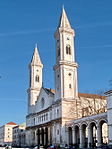Siegestor
1852 establishments in BavariaBuildings and structures completed in 1852Buildings and structures in MunichGates MunichMaxvorstadt ... and 4 more
Neoclassical architecture in MunichRegistered historic buildings and monuments in BavariaTerminating vistas in GermanyTriumphal arches in Germany

The Siegestor (English: Victory Gate) in Munich is a three-arched memorial arch, crowned with a statue of Bavaria with a lion-quadriga. The monument was originally dedicated to the glory of the Bavarian army. Since its restoration following World War II, it now stands as a reminder to peace. The Siegestor is 21 meters high, 24 m wide, and 12 m deep. It is located between the Ludwig Maximilian University and the Ohmstraße, where the Ludwigstraße (south) ends and the Leopoldstraße (north) begins. It thus sits at the boundary between the two Munich districts of Maxvorstadt and Schwabing.
Excerpt from the Wikipedia article Siegestor (License: CC BY-SA 3.0, Authors, Images).Siegestor
Leopoldstraße, Munich Schwabing - Ost (Schwabing-Freimann)
Geographical coordinates (GPS) Address Nearby Places Show on map
Geographical coordinates (GPS)
| Latitude | Longitude |
|---|---|
| N 48.152222222222 ° | E 11.581944444444 ° |
Address
Leopoldstraße
Leopoldstraße
80802 Munich, Schwabing - Ost (Schwabing-Freimann)
Bavaria, Germany
Open on Google Maps




